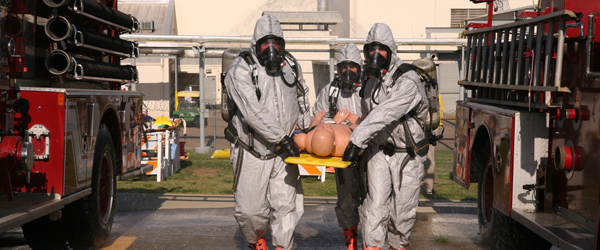Hazardous Materials Incidents
 Chemicals are found everywhere. They purify drinking water, increase crop production and simplify household chores. But chemicals also can be hazardous to humans or the environment if used or released improperly. Hazards can occur during production, storage, transportation, use or disposal. You and your community are at risk if a chemical is used unsafely or released in harmful amounts into the environment where you live, work or play.
Chemicals are found everywhere. They purify drinking water, increase crop production and simplify household chores. But chemicals also can be hazardous to humans or the environment if used or released improperly. Hazards can occur during production, storage, transportation, use or disposal. You and your community are at risk if a chemical is used unsafely or released in harmful amounts into the environment where you live, work or play.
Hazardous materials in various forms can cause death, serious injury, long-lasting health effects and damage to buildings, homes and other property. Many products containing hazardous chemicals are used and stored in homes routinely. These products are also shipped daily on the nation's highways, railroads, waterways and pipelines.
Chemical manufacturers are one source of hazardous materials, but there are many others, including service stations, hospitals and hazardous materials waste sites.
Varying quantities of hazardous materials are manufactured, used or stored at an estimated 4.5 million facilities in the United States--from major industrial plants to local dry cleaning establishments or gardening supply stores.
Hazardous materials come in the form of explosives, flammable and combustible substances, poisons and radioactive materials. These substances are most often released as a result of transportation accidents or because of chemical accidents in plants.
Before
 Before a Hazardous Materials Incident
Before a Hazardous Materials Incident
Many communities have Local Emergency Planning Committees (LEPCs) whose responsibilities include collecting information about hazardous materials in the community and making this information available to the public upon request. The LEPCs also are tasked with developing an emergency plan to prepare for and respond to chemical emergencies in the community. Ways the public will be notified and actions the public must take in the event of a release are part of the plan.
Contact the LEPCs to find out more about chemical hazards and what needs to be done to minimize the risk to individuals and the community from these materials. Your local emergency management office can provide contact information on the LEPCs. Find your state office or agency of emergency management
The following are things you can do to protect yourself, your family and your property from the effects of a hazardous materials incident:
- Build an Emergency Supply Kit, which includes items like non-perishable food, water, a battery-powered or hand-crank radio, extra flashlights and batteries. You should add plastic sheeting, duct tape and scissors to the kit in order be better prepared for a hazardous materials incident. You may want to prepare a portable kit and keep it in your car in case you are told to evacuate.
- Make a Family Emergency Plan. Your family may not be together when disaster strikes, so it is important to know how you will contact one another, how you will get back together and what you will do in case of an emergency.
During
During a Hazardous Materials Incident
Listen to local radio or television stations for detailed information and instructions. Follow the instructions carefully. You should stay away from the area to minimize the risk of contamination. Remember that some toxic chemicals are odorless.
|
If you are: |
Then: |
|---|---|
|
Asked to evacuate |
Do so immediately. Stay tuned to a radio or television for information on evacuation routes, temporary shelters, and procedures. Follow the routes recommended by the authorities--shortcuts may not be safe. Leave at once. If you have time, minimize contamination in the house by closing all windows, shutting all vents, and turning off attic fans. Take pre-assembled disaster supplies. Remember to help your neighbors who may require special assistance--infants, elderly people and people with access and functional needs. |
|
Caught Outside |
Stay upstream, uphill, and upwind! In general, try to go at least one-half mile (usually 8-10 city blocks) from the danger area. Move away from the accident scene and help keep others away. Do not walk into or touch any spilled liquids, airborne mists, or condensed solid chemical deposits. Try not to inhale gases, fumes and smoke. If possible, cover mouth with a cloth while leaving the area. Stay away from accident victims until the hazardous material has been identified. |
|
In a motor vehicle |
Stop and seek shelter in a permanent building. If you must remain in your car, keep car windows and vents closed and shut off the air conditioner and heater. |
|
Requested to stay indoors |
Bring pets inside. Close and lock all exterior doors and windows. Close vents, fireplace dampers, and as many interior doors as possible. Turn off air conditioners and ventilation systems. In large buildings, set ventilation systems to 100 percent recirculation so that no outside air is drawn into the building. If this is not possible, ventilation systems should be turned off. Go into the pre-selected shelter room. This room should be above ground and have the fewest openings to the outside. Seal gaps under doorways and windows with wet towels or plastic sheeting and duct tape. Seal gaps around window and air conditioning units, bathroom and kitchen exhaust fans, and stove and dryer vents with duct tape and plastic sheeting, wax paper or aluminum wrap. Use material to fill cracks and holes in the room, such as those around pipes. If gas or vapors could have entered the building, take shallow breaths through a cloth or a towel. Avoid eating or drinking any food or water that may be contaminated. |
Shelter Safety for Sealed Rooms
Ten square feet of floor space per person will provide sufficient air to prevent carbon dioxide build-up for up to five hours, assuming a normal breathing rate while resting.
However, local officials are unlikely to recommend the public shelter in a sealed room for more than 2-3 hours because the effectiveness of such sheltering diminishes with time as the contaminated outside air gradually seeps into the shelter. At this point, evacuation from the area is the better protective action to take.
Also you should ventilate the shelter when the emergency has passed to avoid breathing contaminated air still inside the shelter.
After
After a Hazardous Materials Incident
The following are guidelines for the period following a hazardous materials incident:
- Go to a designated public shelter if you have been told to evacuate or you feel it is unsafe to remain in your home. Text SHELTER + your ZIP code to 43362 (4FEMA) to find the nearest shelter in your area (example: shelter 12345).
- Act quickly if you have come in to contact with or have been exposed to hazardous chemicals.
- Follow decontamination instructions from local authorities. You may be advised to take a thorough shower or you may be advised to stay away from water and follow another procedure.
- Seek medical treatment for unusual symptoms as soon as possible.
- Place exposed clothing and shoes in tightly sealed containers. Do not allow them to contact other materials. Call local authorities to find out about proper disposal.
- Advise everyone who comes in to contact with you that you may have been exposed to a toxic substance.
- Listen to local radio or television stations for the latest emergency information.
- Help a neighbor who may require special assistance - infants, elderly people and people with access and functional needs. People who care for them or who have large families may need additional assistance in emergency situations.
- Return home only when authorities say it is safe. Open windows and vents and turn on fans to provide ventilation.
- Find out from local authorities how to clean up your land and property.
- Report any lingering vapors or other hazards to your local emergency services office.
More Information
Related Websites
Find additional information on how to plan and prepare for a hazardous materials incident and learn about available resources by visiting the following websites:
- Federal Emergency Management Agency
- American Red Cross
- Department of Translation Pipeline and Hazardous Materials Safety Administration
Listen to Local Officials
Learn about the emergency plans that have been established in your area by your state and local government. In any emergency, always listen to the instructions given by local emergency management officials.

